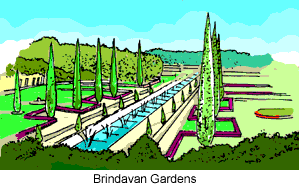
Dimdima
Online Children's Magazine from India

Dimdima
Online Children's Magazine from India
The waters of the Kaveri had been harnessed by India's first hydro-electric station (started in 1902) at Sivasamudram, about 35 km downstream from Kannambadi. It supplied power to the Kolar gold-mines (now shut down). But during the dry months, the supply of electricity became erratic and sometimes non-existent.
 When the manager of the mines came to Visvesvaraya with a request for steady power to work the hoists, the chief engineer saw his chance of building a dam that would not only benefit the Kolar gold fields but also thousands of farmers. The Maharaja of Mysore Krishnaraja Wodeyar IV, was at first taken aback at the immensity of the task: a dam costing rupees 2.5 crore- as much money as the state had spent on irrigation in the previous 50 years! But he finally agreed to render full support to the scheme.
When the manager of the mines came to Visvesvaraya with a request for steady power to work the hoists, the chief engineer saw his chance of building a dam that would not only benefit the Kolar gold fields but also thousands of farmers. The Maharaja of Mysore Krishnaraja Wodeyar IV, was at first taken aback at the immensity of the task: a dam costing rupees 2.5 crore- as much money as the state had spent on irrigation in the previous 50 years! But he finally agreed to render full support to the scheme.
In 1911, the foundations of the Kannambadi dam were laid. It was designed to be 2,621 m long and 43 m high. The reservoir was to have a capacity of 1400 million cubic metres of water. By 1915, the dam was raised to the height of 24m. The Kolar gold-mines could now obtain a regular supply of electricity. The dam was raised to its full height in 1924.
And it was not concrete, but an indigenously prepared material called 'surkhi' that made the dam possible. Surkhi was well-burnt brickbats ground together with unslaked lime. It was cheap and easily available in the vicinity. It set slowly, but when it did, it had as much strength as cement. In this case, surkhi had given the Kannambadi dam ten times the strength that it actually required.
The dam was named 'Krishnarajasagara' after the Maharaja. The Brindavan gardens 18 m below the dam became a trendsetter when work began on it in 1927. Other large Indian dams later developed similar gardens. The 8-hectare gardens, laid out in three terraces, was opened to the public in 1936.
Last updated on :11/3/2003
Dimdima is the Sanskrit word for ‘drumbeat’. In olden days, victory in battle was heralded by the beat of drums or any important news to be conveyed to the people used to be accompanied with drumbeats.
Bharatiya Vidya Bhavan
K. M Munshi Marg,
Chowpatty, Mumbai - 400 007
email : editor@dimdima.com
Bharatiya Vidya Bhavan
505, Sane Guruji Marg,
Tardeo, Mumbai - 400 034
email : promo@dimdima.com
Dimdima.com, the Children's Website of Bharatiya Vidya Bhavan launched in 2000 and came out with a Printed version of Dimdima Magazine in 2004. At present the Printed Version have more than 35,000 subscribers from India and Abroad.